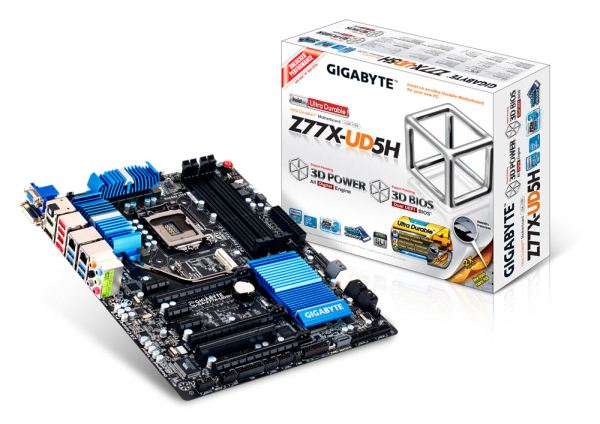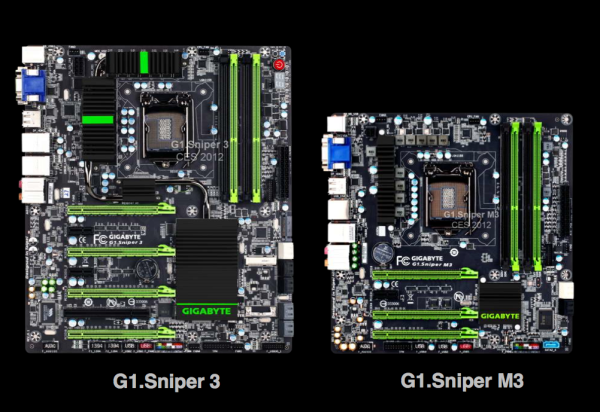A Brief Look at Some Upcoming 7-Series Motherboards
by Ian Cutress on March 9, 2012 5:00 PM EST- Posted in
- Motherboards
- Intel
- H77
- Z77
Gigabyte
Whenever a new chipset comes out, Gigabyte tend to do one of two things – either release a few boards to cover particular price points (usually models from UD3 to UD7), or release more than 10 or even 20+ products for the chipset. This latter method of attacking the market could perhaps overwhelm users into deciding which model to purchase, or that reviews could end up with so many boards to review it is hard to decipher which are the important ones. Nevertheless, Gigabyte for the 7-series launch has decided to attack the market with the latter, in the following models:
Gigabyte G1.Sniper 3
Gigabyte G1.Sniper M3
Gigabyte GA-Z77X-UD5H Wifi
Gigabyte GA-Z77X-UD5H
Gigabyte GA-Z77X-UD3H Wifi
Gigabyte GA-Z77X-UD3H
Gigabyte GA-Z77X-D3H
Gigabyte GA-Z77-D3H
Gigabyte GA-Z77-DS3H
Gigabyte GA-Z77MX-D3H
Gigabyte GA-Z77M-D3H
Gigabyte GA-H77-DS3H
Gigabyte GA-H77M-D3H
Gigabyte GA-B75M-D3H
Gigabyte GA-B75M-D3V
‘D’ means ‘All solid capacitor design’
‘U’ means ‘Double copper PCB design’
My guess is that this list is by no means complete, exhaustive or final (and perhaps includes models for sale in other parts of the world). No doubt we will see a UD4/UD4H, all the way up to UD7 as well. Gigabyte does have a microsite dedicated to their 7-series products, which does provide an informative list of what should be on offer.
The main features Gigabyte is going to be advertising with their 7-series launch is the almost ubiquitous placing of mSATA connectors on most of their boards, and that the UD3 and above boards come with wifi cards.
Gigabyte GA-Z77X-UD5H
Almost at the top of Gigabyte’s range at release is the GA-Z77X-UD5H. We see that the placement of the mSATA port is just below the CPU, which in the grand scheme of things should be ok as long as the user never wants to remove it (I can just imagine it being relatively stressful to take it out when a system is built and in a case). Also, all the boards in the range have both D-Sub and DVI outputs on the IO, which means on some models that they take up space for any PS/2 ports. This is despite the UD5H still sporting a PCI slot for legacy, even if it is taken up if a second dual slot GPU is used. As always, all Gigabyte models should support TPM, and in the case of the UD5, we have extra SATA ports and dual USB 3.0 headers onboard – all of which would be obscured by a full length third GPU.
G1.Sniper 3 and G1.Sniper M3
If we go back all the way to CES this year, Anand caught glimpse of the G1.Sniper series that Gigabyte had on display:
Given what we know about the Gigabyte range, we have some features to point out – if you want mSATA, it looks like you have to invest in a full size ATX style board. Unfortunately, that also means investing in a board that uses a PLX chip to give 4-way x8 performance for multi-GPU setups. Both boards seem to have specialized capacitors to deal with their audio solutions, which on the Gigabyte microsite states is the Creative Sound Core 3D – which is a step in a positive direction from normal Realtek audio solutions.


















55 Comments
View All Comments
mbf - Monday, March 12, 2012 - link
Is ECC support on the P8Z77 WS confirmed? Last generation ECC for Sandy Bridge-based (Xeon) processors was only introduced with the P8B WS, which uses the C206 chipset, and not, for instance, the P8P67 WS Revolution, which uses the P67 chipset.ASUS itself doesn't say one way or the other (http://www.asus.com/Motherboards/Intel_Socket_1155...
Don't get me wrong. I'd _really_ love ECC support on the P8Z77 WS, but somehow I doubt it.
ven - Monday, March 12, 2012 - link
at least this time intel didn't do any crazy things like limiting the IGP access to selected chipset (P67,they purposely removed that feature just because for that lucid Logix virtu thing(Z68), I think it doesn't create any difference most of them used the discrete graphics card as the primary graphics engine.completely useless feature)one thing i hate with 7 series is still it is supporting only 2 SATA-III port, those marvell and asmedia ports performance are no match for the intel.
Still no hint of thunderbolt,maybe waiting for haswell.
st.bone - Monday, March 12, 2012 - link
Oh Thunderbolt is here.... Check this out:Thunderbolt Port Pictured on MSI Z77A-GD80
http://www.techpowerup.com/161912/Thunderbolt-Port...
ven - Monday, March 12, 2012 - link
is it native to Z77? then why didn't all motherboards has this feature?mmaestro - Monday, March 12, 2012 - link
Would love to see some stuff on the H77 boards. SRT on an entry-level board should give some great idiot-proof performance boosting for the folks who just need a basic system to deal with media, web browsing, email, and office apps.MobiusStrip - Monday, March 12, 2012 - link
Wasn't Thunderbolt supposed to be on-board finally?mbf - Tuesday, March 13, 2012 - link
No, USB3 is finally on-board. Thunderbolt is just no longer an "Apple Exclusive". Apart from that, the Thunderbolt chip costs a pretty penny as well.Arbie - Tuesday, March 13, 2012 - link
I hope you'll review the Asus Sabertooth Z77 board, with some emphasis on its thermal armor and fan control suite.Reviews of the board's predecessors have either left the thermal armor with no fan, or have installed the fan backwards. Asus evidently provides no guidance on this, and may not even include the fan. As a result, there have been no good reviews of what the armor achieves.
The design of the armor shows that an exhaust fan is expected. This will pull warm air out of the covered areas and dump it into the space above the fan port (between CPU cooler and graphics board etc). This should help the protected motherboard components run cooler. However, there remain questions of physical interference between the fan and the card slots, especially the 1x slot nearest the fan port. Also, what fan size is required, and is there a best choice for this?
I'd also like to know what thermal sensors are supported by the mobo and its BIOS, how many PWM headers there are and what they control on, and any other details that will help plan a build.
Asus stands out in its support for air cooling of an overclocked rig in a real-world PC case, and I think that what they offer should be evaluated for its benefits. Reviewers too often shortcut or simply ignore such provisions because they are testing on an open chassis. So most manufacturers feel free to shortcut the issues as well. But consumers buying the boards will be using them very differently, and case cooling is VERY important.
Far less important to me are extra slots and PLX-type chips for SLI graphics boards. Given the glacial improvements in PC games, a single board is all I need or want. Given the practical drawbacks, I'd bet that only a small fraction of enthusiasts (which is already a very small group) actually run two boards.
Thanks
colonelclaw - Wednesday, March 14, 2012 - link
It's a bit annoying that none of these chip-sets supports 8 RAM slots, but then I guess that would be cannibalising the more expensive kit. As someone who works in 3D graphics for a living it makes me slightly wince to see that Asus board labeled 'Workstation' with just 4 RAM slots. Intel sure likes to squeeze as much money out of us as they can now that they make the undisputed best processors, not that I can blame them for doing so, after all they're not a charity.Are there any chips that have more than 4 cores/8 threads that you can put in any of these boards? It's funny, 4 cores seemed like like so much just a few years ago, nowadays it feels like the bare minimum acceptable.
coachingjoy - Sunday, March 18, 2012 - link
Any mITX goodness available?Thanks.